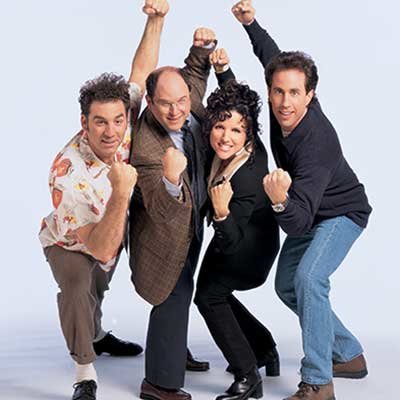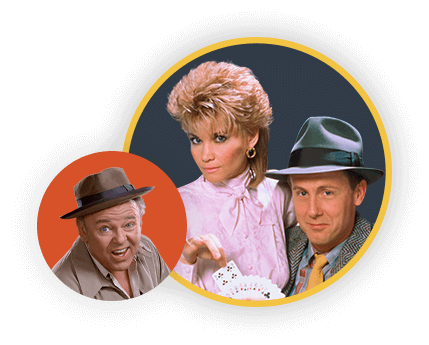9 groundbreaking TV shows turning 30 years old in 2019

By the end of the Eighties, there was so much more television. The Fox Network continued to expand, adding a fourth option. Meanwhile, syndication and cable became big money makers. The 1989 season also introduced a slew of shows that reshaped modern television. The nine titles below all played a part, to varying degrees, in defining what kinds of stories would click with audiences in the 21st century.
Heck, a couple of them are still going!
Let's take a look at these influential series and see what they each proved to programmers and audiences.

Seinfeld
What it proved: Irony was the new form of comedy
It's hard to believe Seinfeld is three decades old because it still feels so fresh. Reruns continue to air — and fit right in with whatever new programs follow it. Think about how dated '30s content felt in the '60s, or '60s content in the '90s. Heck, in some ways, Seinfeld feels more cutting edge than popular sitcoms of today. (Big Bang Theory and its ilk look more to Friends.) From its plethora of characters to its intricate, absurdist plots, Seinfeld set the mold for the modern sitcom.

The Simpsons
What it proved: Being animated has its advantages
The Flintstones and The Jetsons proved that cartoons can click with viewers in primetime, but networks largely shied away from the idea for a quarter century. Perhaps people were really hungry for more animated sitcoms, because The Simpsons took off like a rocket. And no wonder. With it's animated medium, The Simpsons could put anything — or anyone — onscreen, regardless of the budget. Plus, no need to worry about characters aging. Merchandising, from bootleg Bart T-shirts and 7-Eleven tie-ins, burned the yellow family into the fabric of American culture.
Image: The Everett Collection

Saved by the Bell
What it proved: Kids want their own sitcoms
Technically, it was a second chance. Zach and Screech first appeared in the Disney Channel sitcom Good Morning, Miss Bliss. After moving to NBC, the sitcom underwent significant, smart changes, starting with the title and setting. Why focus on the teacher? Also, kids dream of going to school in California, not Indiana. With its gaudy, neon colors and patterns, Saved by the Bell ushered in '90s fashion. Copycat shows immediately followed in its wake (California Dreams, anyone?) while Nickelodeon and Disney have been churning out clones of the concept ever since.

Baywatch
What it proved: Syndication + swimsuits + slow motion = success
Believe it or not, it has a lot in common with Mama's Family. Both series started on network television before finding a long second life in syndication. Of course, Pamela Anderson wore much less costume than Vicki Lawrence.
Image: The Everett Collection

America's Funniest Home Videos
What it proved: The future is viral
Viral videos are a cheap thrill. For starters, you don't have to film them. Let the fans submit content. Secondly, people have a natural fascination with humans and kittens falling over. Somehow, despite the existence of YouTube, AFHV continues to this day. Well, it's not that much of a mystery. It costs next to nothing to produce. And every American has a camera.
Image: The Everett Collection

Doogie Howser, M.D.
What it proved: Child stars could have long careers and nerds could be cool
Who could have imagined that Neil Patrick Harris would become an institution? In the '80s, child stars typically flamed out tragically. The Coreys, the Drummond kids, etc. Perhaps NPH navigated Hollywood successfully because he was acting like an adult from the get-go. Doogie fused three shows into one — coming of age tale, medical drama and sitcom. How did we go from mocking smart people in Revenge of the Nerds to having supermodels bragging about being "nerds"? Well, Doogie had something to do with it.
Image: The Everett Collection

Coach
What it proved: There was more to sports than the games
With the 24-hour news machine and social media, sports is hardly even about the actual sports anymore. Nah — debate, interviews, profiles, highlights, Tweets. That's where the attention is. Back in the day, sports were games. You watched them, cheered for them, but hardly cared to know them as people. Athletes and coaches for icons, Greek gods. Coach humanized the profession to some extent. Coaches could be goofy, romantic, complicated. More importantly, they could be funny.
Image: The Everett Collection

Quantum Leap
What it proved: The best concept is any concept
Seinfeld famously dubbed itself a "show about nothing." Truly, it was a show about anything. In that regard, it has something in common with Quantum Leap. This brilliant, sci-fi concept (a man jumping through time, in and out of other people's bodies) allowed the series to morph each week. A medieval adventure? Sure. A World War II romance? Okay. This kind of anything-goes mentality led to action shows doing, say, musical episodes, or flashback period pieces. Continuity isn't everything.
Image: The Everett Collection

Life Goes On
What it proved: Big heart (and the Beatles) equal big ratings
Ob-la-di, ob-la-da… Landing the Beatles for a theme song was a major get. But Life Goes On connected people because of characters, not music. Chris Burke (Corky) became the first actor with Down syndrome to star on a television series. With its focus on the highs and lows of family life, Life Goes On set the mold for tearjerking drama like This Is Us.
Image: The Everett Collection

SEE ALSO: 8 popular TV shows turning 40 years old in 2019
Buck, Blair and Daisy Duke all have big birthdays coming up. READ MORE




